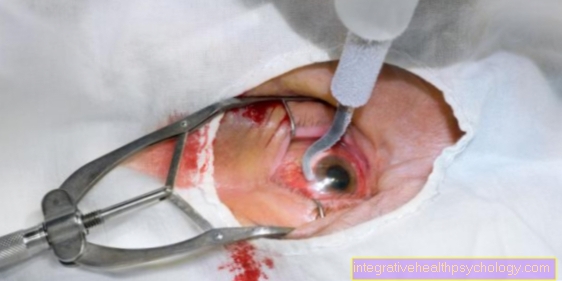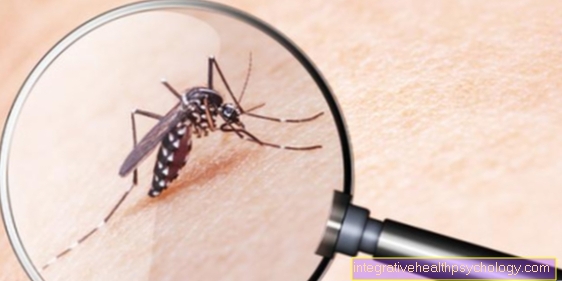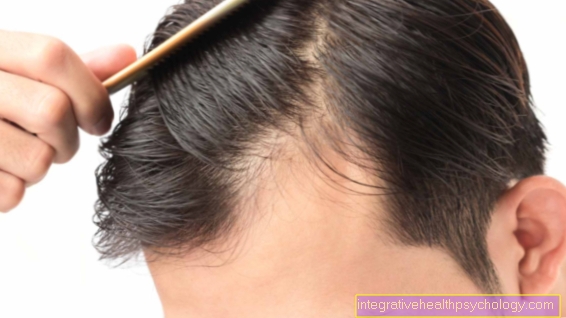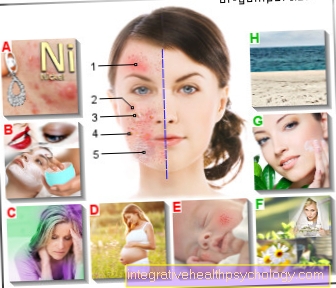Removal of xanthelasma
introduction
Xanthelasma are deposits of fat in the skin around the eyelid.
Read more on the topic: Causes of Xanthelasma
Removal is only medically indicated in the case of visual impairment and is therefore considered a cosmetic operation that is not covered by the health insurance fund and therefore has to be paid for yourself.
Cosmetically disturbing xanthelasma can be removed both surgically and with laser therapy. There are the following therapy methods:
- the surgical excision
- Electrocautery
- the CO2 and Er: YAG laser ablation
- cryosurgery
- laser coagulation using argon, dye or KTP lasers
- the etching with 50 percent trichloroacetic acid

Operation of xanthelasma
Surgical clearance is beneficial if there is also dermatochalasis (drooping eyelid) with large excess skin in the upper and lower eyelid area, which can then be eliminated at the same time. After the surgical excision, a scar arises and is often problematic, especially with large xanthelasma. Repeat treatment in the event of recurrence of xanthelasma is not possible as often as desired due to the scar after surgical removal. Since the operation also injures vessels, severe reddening often occurs after the treatment, which is an unacceptable side effect for many patients.
Read more on the topic: Operation of xanthelasma
Xanthelasma often recurs after surgical removal. In a 1979 study by Mendelsohn, 40% had repeated xanthelasmata after the first procedure and 60% after the second procedure.
Surgery costs
Similar to laser treatment, the surgical measures to remove the xanthelasma depend on the size, number and other factors. It is difficult to give general standard prices. Since there are different measures, the prices also vary with regard to the respective measure (ice, electricity, acid treatment, eyelid lift or treatment with a scalpel). The rules of the doctors' fee schedule, which are regularly changed, also apply here. As a rule, the costs for the surgical measures without a laser remain in the higher double-digit range.
Laser treatment of xanthelasma
There are various laser methods for removing xanthelasma such as the dye laser, CO2 laser or Er: YAG laser. The choice of the appropriate method depends on the patient's expectations and needs. Often only a short-term absence from work should take place and the patients want minimally invasive methods. An individually suitable therapy should, however, be selected based on the overall findings and the anatomy of the lid region.
A treatment with the dye laser is only successful in the early stages of very flat xanthelasma and several treatments must be expected.
Laser ablation using a CO2 laser or Er: YAG laser always creates a wound surface that only heals a few days later.
With a CO2 laser, a scar-free removal of the xanthelasma could be achieved in studies. Only hyper- or hypopigmentation occurred in a few of the patients treated in this way.
The Er: YAG laser is also very effective, has few side effects and only a few recurrences (recurrence of the xanthelasma); healing takes even less time with superficial xanthelasma than with the CO2 laser.
Laser treatment costs
The cost of laser removal of xanthelasma depends on the size and number of these lipid deposits. In addition, this treatment is not a medical indication and usually has to be paid for yourself. This gives the attending physician or the attending clinics a certain amount of leeway in determining the fees. Therefore, the costs vary enormously from the higher two- to mid-three-digit range. However, the costs of laser treatment of xanthelasma are also subject to the German fee schedule for doctors. Each service is specified there with a point or monetary value. However, based on a written individual agreement, the basic price from the Fee Ordinance can be multiplied by a new factor. Nevertheless, it is fundamentally true that “appropriateness” must be observed. Accordingly, one can compare the prices offered for laser treatment of xanthelasma.
Cryosurgery
In cryosurgery, cold stimuli are used to remove the xanthelasma. Precise icing takes place. However, this can be painful. Therefore the eyelid is anesthetized locally beforehand. The tissue covered with xanthelasma is destroyed by the ice treatment. Within a few weeks, it encapsulates and is broken down by the body. As a result, new, healthy tissue is created in the same place. However, the xanthelasma can regress.
Etching with trichloroacetic acid
Xanthelasma can also be removed with the help of trichloroacetic acid. Here the lipid deposits are burned. This creates space so that new healthy tissue can grow at this point. However, this method usually creates scars. There is also a risk that untrained personnel could injure the eyes. There is also a risk that there will be problems closing the eyelids afterwards.
Home remedies for xanthelasma
Some authors recommend using kombucha, apple cider vinegar and drinking enough water as home remedies for xanthelasma. The use of medicinal plants such as birch, nettle, garlic and onions are also recommended. Some authors recommend using Schüssler salts. The effectiveness of home remedies for xanthelasma is controversial.
You might also be interested in this topic: Homeopathy for Xanthelasma
What are the risks?
With all treatments there is a risk that the xanthelasma will form again. The risk of a new formation is lowest with an eyelid lift.
Read more on the topic: Eyelid lift
Scars can occur when using a scalpel or trichloroacetic acid. During treatment with electricity, the so-called electrocautery, inflammation develops. The laser treatment can lead to bruising, blistering, pigment changes in the skin, in the worst case it can lead to scarring and swelling of the eyes and face.
Since the xanthelasma are close to the eye, injury to the eye cannot be completely ruled out with any treatment. However, these injury risks are very low with trained personnel. All procedures can lead to wound pain and inflammation. Local anesthesia can cause allergic reactions and intolerance.
What can be done to prevent the xanthelasma from coming back?
To minimize the risk of xanthelasma relapse, a balanced diet may be advisable. A diet rich in fiber and vitamins should be consumed. The fat metabolism should be checked before and, if necessary, at regular intervals. This applies in particular to younger patients, but is also generally recommended for people of any age if you are unsure. Exercise in the fresh air and not smoking can also have a positive effect on the metabolism and skin texture.
When is it possible for the health insurance company to cover the costs?
Removal of xanthelasma corresponds to cosmetic treatment. It does not count as a medical service. Therefore, the costs are not paid by the statutory health insurance. However, it is possible that privately insured persons will receive a reimbursement. If there is a medical indication for the removal of the xanthelasma in individual cases, the health insurance company may be able to cover the costs.





























